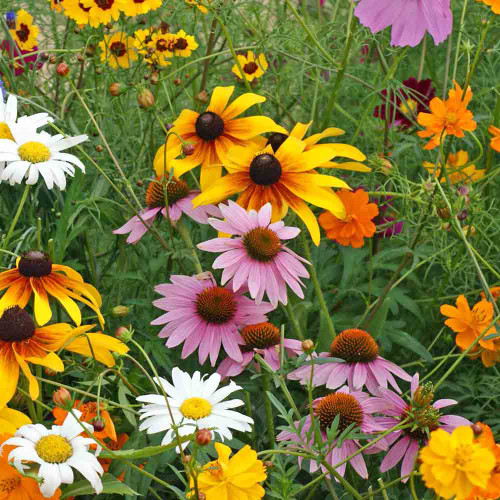Description
Giant Marigold Mix - Aztec Gold: A Legacy of Color
Towering above the familiar clusters of dwarf marigolds that often edge garden paths, these friendly giants invite you closer with their robust stalks and sun-drenched orange blooms, like warm smiles in your summer garden. The cheerful blossoms aren’t just pretty faces; they carry a legacy that spans centuries and continents. The Aztecs revered them as a symbol of the sun; they were used in medicinal remedies and were a source of orange dye. These aren't just ordinary garden marigolds; they're living history, a bold statement in any landscape, and a magnet for pollinators, all wrapped into one surprisingly versatile plant.
Details
These robust marigolds create a substantial visual impact by reaching 3 to 4 feet, with some stretching even taller, offering a significant presence unlike smaller edging marigolds. Their substantial size and upright habit make them well-suited for the back of borders or as striking individual plants in garden beds. They can also be grown in large containers, provided they are at least 10 inches in diameter and deep enough to accommodate staking if needed. The Giant Marigold flowers are a spectacle, with large, double blooms up to 5 inches in diameter, displaying rich, sun-drenched oranges, from deep amber to vibrant tangerine, forming tightly packed, ruffled pom-poms. These aren't timid accents; they are showstopping floral displays that will draw admiration. These blooms provide extended color, from early summer to the first frost. These blooms attract beneficial pollinators and may help deter certain pests, showing good resistance to some common diseases, such as fungal leaf spot.
History
The origins of the Giant Marigold are in Mexico and Guatemala, where it held significant cultural importance for centuries. The Aztecs cultivated them, calling them cempasúchil (meaning 'twenty petals' in Nahuatl). They used this species in religious rituals, medicinal remedies (particularly for digestive issues), and as a dye. Its orange and yellow flowers symbolized the sun and were associated with life and death.
Following the Spanish conquest of the Aztec Empire (1519–1521), explorers introduced seeds to Europe, becoming part of the Columbian Exchange. This species thrived in Mediterranean climates and was widely cultivated in Spain, France, and later across Europe. The name “African Marigold” originated after this plant was introduced to North Africa via European trade routes, where it naturalized, leading to a misconception of its origin.
European colonizers and traders introduced Tagetes erecta to India in the 16th–17th centuries. It became part of Hindu festivals like Diwali and weddings, and is now widely cultivated there.
Uses
These marigolds possess a history in traditional medicine and are a source of lutein, a carotenoid beneficial for eye health. Their rich blooms also play a vital role in the garden, attracting pollinators like bees and butterflies and contributing to a thriving garden. Beyond their practical and aesthetic qualities, these flowers hold deep cultural significance. In Mexico, where the Aztecs cultivated them and knew them as 'cempasúchil,' meaning 'twenty petals' in Nahuatl, the deep orange hues of these marigolds are iconic in Day of the Dead celebrations. Their scent and color are believed to guide the spirits of loved ones home. The flowers symbolize the brevity of life, and they are fashioned into garlands, wreaths, and crosses to decorate altars and gravesites. This flower was also historically known as the 'flower of 400 lives.' The petals have also been used as a natural food coloring and yellow textile dye, sometimes as a saffron substitute.
Companion Planting
Giant Marigold flowers attract pollinators, including bees and butterflies, contributing to garden biodiversity. The plant's aroma repels aphids, whiteflies, and certain beetles, making it useful in vegetable gardens. Ladybugs are often found on its leaves.
Companion planting with basil, beans (broad, runner, and bush), citrus, eggplant, peas, and tomatoes is recommended. Roses, zinnias, sage, and mint also benefit from proximity to marigolds.
Avoid planting marigolds directly adjacent to legume crops, as they can inhibit growth.
Planting and Growing Tips
For optimal results, start seeds indoors 4-6 weeks before the last expected frost. Sow seeds about ¼ inch deep in a well-draining seed-starting mix. Maintain a consistent soil temperature of 70-75°F for germination, typically within 4-14 days. Once seedlings emerge, maintain a daytime temperature of 65-75°F, with a slight nighttime temperature reduction. Provide ample light to prevent etiolation.
Transplant outdoors after the last frost, when soil temperatures have warmed. Space plants at least a foot apart to ensure adequate air circulation and prevent overcrowding.
Direct sowing is also viable once soil temperatures consistently reach 65°F.
Marigolds require full sun, ideally 6-8 hours daily, to promote abundant flowering. In hot climates, light afternoon shade may be beneficial. The ideal soil is moderately fertile and well-drained, accommodating various soil textures. Ensure consistent moisture, especially during establishment, avoiding waterlogging.
Water thoroughly, about one inch per week, allowing the soil to dry slightly between waterings to prevent root rot. Established plants exhibit drought tolerance.
Deadheading spent blooms encourages continuous flowering by preventing seed formation. Taller varieties may require staking for support, particularly in windy conditions.
Harvest Tips
The best time to harvest is when the flowers are fully open but the centers are still tight. Early morning cutting prolongs freshness, ensuring these large, vibrant blooms maintain their impressive display. Their sturdy stems and substantial flower heads make them ideal for cut flower arrangements, bringing a touch of the garden indoors. And the more you cut, the more they'll bloom, so don't hesitate to enjoy their beauty indoors as well. Keep harvesting as long as the plant continues to produce those glorious flowers.
Learn More
From the soil to the seed to the food you eat - we'll help you grow your best garden!















